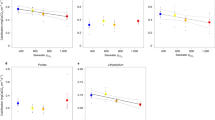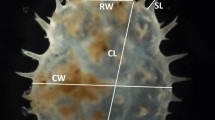Abstract
Ocean acidification, caused by increased atmospheric carbon dioxide (CO2) concentrations, is currently an important environmental problem. It is therefore necessary to investigate the effects of ocean acidification on all life stages of a wide range of marine organisms. However, few studies have examined the effects of increased CO2 on early life stages of organisms, including corals. Using a range of pH values (pH 7.3, 7.6, and 8.0) in manipulative duplicate aquarium experiments, we have evaluated the effects of increased CO2 on early life stages (larval and polyp stages) of Acropora spp. with the aim of estimating CO2 tolerance thresholds at these stages. Larval survival rates did not differ significantly between the reduced pH and control conditions. In contrast, polyp growth and algal infection rates were significantly decreased at reduced pH levels compared to control conditions. These results suggest that future ocean acidification may lead to reduced primary polyp growth and delayed establishment of symbiosis. Stress exposure experiments using longer experimental time scales and lower levels of CO2 concentrations than those used in this study are needed to establish the threshold of CO2 emissions required to sustain coral reef ecosystems.




Similar content being viewed by others
References
Hoegh-Guldberg O, Mumby PJ, Hooten AJ, Steneck RS, Greenfield P, Gomez E, Harvell CD, Sale PF, Edwards AJ, Caldeira K, Knowlton N, Eakin CM, Iglesias-Prieto R, Muthiga N, Bradbury RH, Dubi A, Hatziolos ME (2007) Coral reefs under rapid climate change and ocean acidification. Science 318:1737–1742
Caldiera K, Wickett ME (2003) Anthropogenic carbon and ocean pH. Nature 425:365
Orr JC, Fabry VJ, Aumont O, Bopp L, Doney SC, Feely RA, Gnanadesikan A, Gruber N, Ishida A, Joos F, Key RM, Lindsay K, Maier-Reimer E, Matear RJ, Monfray P, Mouchet A, Najjar R, Plattner GK, Rodgers KB, Sabine CL, Sarmiento JL, Schlitzer R, Slater RD, Totterdell IJ, Weirig MF, Yamanaka Y, Yool A (2005) Anthropogenic ocean acidification over the twenty-first century and its impact on calcifying organisms. Nature 437:681–686
Fine M, Tchernov D (2007) Scleractinian coral species survive and recover from decalcification. Science 315:1811
Marubini F, Christine AE, Ferrier-Page’s AE, Furla P, Allemand D (2008) Coral calcification responds to seawater acidification: a working hypothesis towards a physiological mechanism. Coral Reefs 27:491–499
Bijma J, Honisch B, Zeebe RE (2002) Impact of the ocean carbonate chemistry on living foraminiferal shell weight: comment on “Carbonate ion concentration in glacial-age deep waters of the Caribbean Sea” by Broecker WS and Clark E. Geochem Geophys Geosyst 3:1064. doi:10.1029/2002GC000388
Erez J (2003) The sources of ions for biomineralization in foraminifera and their implications for paleoceanographic proxies. In: Dove PM, De Yoreo JJ, Weiner S (eds) Reviews in minerology and geochemistry, vol 54: biomineralization. Minerological Society of America, Washington D.C., pp 115–149
Gao K, Aruga Y, Asada K, Ishihara T, Akano T, Kiyohara M (1993) Calcification in the articulated coralline alga Corallina pilulifera, with special reference to the effect of elevated CO2 concentration. Mar Biol 117:129–132
Anthony KRN, Kline DI, Diaz-Pulido G, Dove S, Hoegh-Guldberg O (2008) Ocean acidification causes bleaching and productivity loss in coral reef builders. Proc Natl Acad Sci USA 105:17442–17446
Kuffner IB, Andersson AJ, Jokiel PL, Rodgers KS, Mackenzie FT (2008) Decreased abundance of crustose coralline algae due to ocean acidification. Nat Geosci 1:114–117
Raven J, Caldeira K, Elderfield H, Hoegh-Guldberg O, Liss P, Riebesell U, Shepherd J, Turley C, Watson A (2005) Ocean acidification due to increasing atmospheric carbon dioxide. Policy document 12/05. Royal Society, London
Kurihara H (2008) Effects of CO2-driven ocean acidification on the early developmental stages of invertebrates. Mar Ecol Prog Ser 373:275–284
Pörtner HO (2008) Ecosystem effects of ocean acidification in times of ocean warming: a physiologist’s view. Mar Ecol Prog Ser 373:203–217. doi:10.3354/meps07768
Zeebe RE, Zachos JC, Caldeira K, Tyrrell T (2008) Carbon emissions and acidification. Science 321:51–52
Havenhand JN, Buttler FR, Thorndyke MC, Williamson JE (2008) Near-future levels of ocean acidification reduce fertilization success in a sea urchin. Curr Biol 18:R651–R652
Morita M, Suwa R, Iguchi A, Nakamura M, Shimada K, Sakai K, Suzuki A (2009) Ocean acidification reduces sperm flagellar motility in broadcast spawning reef invertebrates. Zygote. doi:10.1017/S0967199409990177
Kurihara H, Shirayama Y (2004) Effects of increased atmospheric CO2 on sea urchin early development. Mar Ecol Prog Ser 274:161–169
Dopont S, Harenhand J, Thorndyke W, Peck L, Thorndyke M (2008) Near-future level of CO2-driven ocean acidification radically affects larval survival and development in the brittlestar Ophiothrix fragilis. Mar Ecol Prog Ser 373:285–294. doi:10.3354/meps07800
Kurihara H, Ishimatsu A (2008) Effects of high-CO2 seawater on the copepod Acartia tsuensi through all life stages and subsequent generations. Mar Pollut Bull 56:1086–1090
Kurihara H, Kato S, Ishimatsu A (2007) Effects of increased seawater pCO2 on early development of the oyster Crassostrea gigas. Aquatic Biol 1:91–98
Kurihara H, Asai T, Kato S, Ishimatsu A (2008) Effects of elevated pCO2 on early development in the mussel Mytilus galloprovincialis. Aquat Biol 4:225–233
Ellis R, Bersey J, Rundle SD, Hall-Spencer JM, Spicer JI (2009) Subtle but significant effects of CO2 acidified seawater on embryos of the intertidal snail, Littorina obtusata. Aquat Biol 5:41–48. doi:10.3354/ab00118
Fabry VJ, Seibel BA, Feely RA, Orr JC (2008) Impacts of ocean acidification on marine fauna and ecosystem processes. J Mar Sci 65:414–432
Kleypas JA, Feely RA, Fabry VJ, Langdon C, Sabine CL, Robbins LL (2006) Impacts of ocean acidification on coral reefs and other marine calcifiers: a guide for future research. Report of a workshop. NSF, NOAA, and the US Geological Survey, St Petersburg, FL
Albright R, Mason B, Langdon L (2008) Effect of aragonite saturation state on settlement and post-settlement growth of Porites astreoides larvae. Coral Reefs 27:485–490
Veron JEN (2000) Corals of the world. Australian Institute of Marine Science, Townsville
Wallace CC (1999) Staghorn corals of the world: a revision of the genus Acropora. CSIRO Publ, Collingwood
Schneider K, Erez J (2006) The effect of carbonate chemistry on calcification and photosynthesis in the hermatypic coral Acropora eurystoma. Limnol Oceanogr 51:1284–1293
Morita M, Nishikawa A, Nakajima A, Iguchi A, Sakai K, Takemura A, Okuno M (2006) Eggs regulate sperm flagellar motility initiation, chemotaxis, and inhibition in the coral, Acropora digitifera, A. gemmifera, and A. tenuis. J Exp Biol 209:4574–4579
Leclercq N, Gattuso JP, Jaubert J (2002) Primary production, respiration, and calcification of a coral reef mesocosm under increased CO2 partial pressure. Limnol Oceanogr 47:558–564
Suwa R, Hirose M, Hidaka M (2008) Seasonal fluctuation in zooxanthella composition and photophysiology in the corals Pavona divaricata and P. decussata in Okinawa. Mar Ecol Prog Ser 361:129–137
Dickson AG, Sabine CL, Christian JR (eds) (2007) Guide to best practices for ocean CO2 measurements. PICES Special Publication 3. North Pacific Marine Science Organization (PICES), Ottawa
Fujimura H, Oomori T, Maehira T, Miyahira K (2001) Change of coral carbon metabolism influenced by coral bleaching. Galaxea 3:41–50
Lewis E, Wallace DWR (1998) Program developed for CO2 system calculations, ORNL/ CDIAC-105. Carbon Dioxide Information Analysis Center, Oak Ridge National Laboratory, Oak Ridge
Iwao K, Fujisawa T, Hatta M (2002) A cnidarian neuropeptide of the GLWamide family induces metamorphosis of reef-building corals in the genus Acropora. Coral Reefs 21:127–129
Yuyama I, Hayakawa H, Endo H, Iwao K, Takeyama H, Maruyama T, Watanabe T (2005) Identification of symbiotically expressed coral mRNAs using a model infection system. Biochem Biophys Res Commun 336:793–798
Hirose M, Yamamoto H, Nonaka M (2008) Metamorphosis and acquisition of symbiotic algae in planula larvae and primary polyps of Acropora spp. Coral Reefs 27:247–254
Clark D, Lamare M, Barker M (2009) Response of sea urchin pluteus larvae (Echinodermata: Echinoidae) to reduced seawater pH: a comparison among a tropical, temperate, and a polar species. Mar Biol 156:1125–1137. doi:10.1007/s00227-009-1155-8
Suzuki A, Nakamori T, Kayanne H (1995) The mechanism of production enhancement in coral reef carbonate systems: model and empirical results. Sediment Geol 99:259–280
Reipschläger A, Pörtner HO (1996) Metabolic depression during environmental stress: the role of extra- versus intracellular pH in Sipunculus nudus. J Exp Biol 199:1801–1807
Michaelidis B, Ouzounis C, Paleras A, Pörtner HO (2005) Effects of long-term moderate hypercapnia on acid–base balance and growth rate in marine mussels Mytilus galloprovinciallis. Mar Ecol Prog Ser 293:109–118
Guppy M, Withers PC (1999) Metabolic depression in animals: physiological perspectives and biochemical generalizations. Biol Rev 74:1–40
Nishikawa A, Katoh M, Sakai K (2003) Larval settlement rates and gene flow of broadcast-spawning (Acropora tenuis) and planula-brooding (Stylophora pistillata) corals. Mar Ecol Prog Ser 256:87–97
Nishikawa A, Sakai K (2005) Settlement-competency period of planulae and genetic differentiation of the scleractinian coral Acropora digitifera. Zool Sci 22:391–399
Babcock RC (1991) Comparative demography of three species of scleractinian corals using age- and size-dependent classifications. Ecol Monogr 61:225–244
Babcock R, Mundy C (1996) Coral recruitment: consequences of settlement choice for early growth and survivorship in two scleractinians. J Exp Mar Biol Ecol 206:179–201
Shirayama T, Thornton H (2005) Effects of increased atmospheric CO2 on shallow water marine benthos. J Geophys Res 110:1–7
Acknowledgments
We are grateful to Mayuri Inoue and Hodaka Kawahata for their support to K. Shimada. This program was supported by AICAL project (Acidification Impact on CALcifiers, leaded by Yukihiro Nojiri) funded by Global Environment Research Fund B-084 of Ministry of the Environment of Japan.
Author information
Authors and Affiliations
Corresponding author
Additional information
R. Suwa and M. Nakamura contributed equally to this work.
Rights and permissions
About this article
Cite this article
Suwa, R., Nakamura, M., Morita, M. et al. Effects of acidified seawater on early life stages of scleractinian corals (Genus Acropora). Fish Sci 76, 93–99 (2010). https://doi.org/10.1007/s12562-009-0189-7
Received:
Accepted:
Published:
Issue Date:
DOI: https://doi.org/10.1007/s12562-009-0189-7




